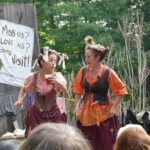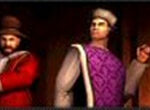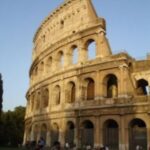The Italian Renaissance was a wonderful and culturally rich place to live. After the Medieval Ages (the “dark” or “middle” ages) Italy flourished as a country. With the fall of Constantinople and the remnants of the old Roman Empire still smoldering in the wind, Italy had a unique development just around the corner. The wonderful era of “rebirth” was about to unfold before all of Europe and for two hundred years, would remain to be one of the single most important time frames in history.
Italy between the 14th and 16th century would be the best place to live and breathe, especially since you’d be sharing the same air as famous thinker Machiavelli, not to mention being able to see the famous works of Leonardo Da Vinci and Michelangelo, or even Raphael. Yes, these were very important and renovating times. Anyone would be happy to live there, even the Catholic Church made its home in Rome. (Gates)
Machiavelli was famous for his great words of thought and passion for philosophy. On May 3rd 1469, one of the greatest thinkers to enter the renaissance world was born. His ideas paved the way for new thinking and concepts that caused much debate. He built his philosophy on the realm of virtue, fortune, and power. He believed that the state was priority before all else, government was necessary to control people, and, the most famous, that the ends justify the means. He might have seemed cruel to some but as it turns out, Machiavelli was actually a good man with strong values.
Leonardo Da Vinci was a famous painter of the Renaissance. His work went well beyond art though. He had numerous inventions. Some would call him a genius. He had stacks of papers in his office of inventions including early models of airplanes, armored car, and the machine gun.
What Italy holds best, other than food, is festivals and celebrations. One of the most widely known celebrations was the Venice Carnival, pronounced in Italian as Carnevale di Venezia. It’s dated back to the fifteenth century but it can be traced back to the fourteenth. What makes the Carnevale so special to everyone in Italy is the fact that everyone participating usually wore elaborate masks. Typical masks had pointed noses and gilded-painted metallic-features. However some only cover the top part of the face. Another mask type is the Volto, or “face”. This mask is the simplest mask to make and usually has a more practically approach to the festival, allowing the mask wearer to eat and drink freely without damaging their hidden identity.
The Carnival in Venice claims to have originated as a celebration of an important victory over the Repubblica della Serenissima. Of course, the main reason for the celebration in Venice is for fun and business. Venice was a very influential republic at that time and what happened in Venice was influencul to all of Europe. Nobles, Paupers, Cardinals…they all enjoyed the music, food, and wine. Business flourished in this time as well and mask makers were definitely getting the best profit.
Who could forget where Italian food came from? Italy is known for its food and more yet, not many people know the difference between southern and northern Italian food. The Italian cuisine has slowly progressed through the ages. The oldest cookbook known to man is also credited to the region (food). Northern Italian cuisine is strikingly different from the rest of the peninsula. Its best known dishes are actually composed of rice. The most famous of which is risotto. A lot of Northern cuisine is catered to the climate. In the north its simply colder so richer stews and soups are required. In Southern Italy, tomatoes are put in almost everything, while the north doesn’t use them very often because they aren’t as readily available. Southern Italian food is also rich with pork because the land wasn’t fertile enough to have cattle. Also, the olive tree was fertile in the south so southern cooking was based in olive oil, rather than creamy sauces that smother the flavor of seasoning.
Aside from the food and festivals, Renaissance Italy had a lot to offer. As Education comes into play, we see a lot of children in school at this time. Out of one-hundred-thousand people who lived in Florence at this time, 8,000 children attended school. In this era, that was phenomena (Gates).
Shockingly, Crime wasn’t that bad in Italy during the fifteenth and sixteenth century. In all actuality, they had a wide array of police force that was traditionally militarized. This police force patrolled at night as well as during the day and also carried important papers for higher up socialites and magistrates. The captain, the commander, kept in contact with the criminal world by the use of informants. They also had an emergency protocol to help with violent crowds and situations. (Crime)
The Church even set up emergency relief for the poor. They split them up into two groups, the holy poor, which they considered unable to work children, mothers, and then the rogues, which were an adapted term from the medieval times that described a well-abled man who was banished from his home and lived a life on the fringes. (Crime)
Great minds, education, protected by police, faith at your fingertips…Italy wasn’t that bad. That’s why people should have lived there if they could have. Clean water, the best food on the planet, and strong desire for knowledge and art. What more could you ask for?
“Crime and Punishment.” Encyclopedia of the Early Modern World. The Gale Group, Inc, 2004. Answers.com 30 Jan. 2012. http://www.answers.com/topic/crime-and-punishment-history-1450-1789
Gates, Dr. Larry E. “The Italian Renaissance.” HistoryDoctor.net. Ed. Dr. Larry E. Gates. Georgetown High-school, n.d. Web. 22 Jan. 2012. .
“Italian Renaissance.” 2012. The History Channel website. Jan 22 2012, 7:00 <http://www.history.com/topics/italian-renaissance.>
“Italian Renaissance Food.” Country Facts. Country Facts, 29 Mar. 2010. Web. 26 Jan. 2012. .
“Life in Italy During the Renaissance.” lifeinitaly.com. Life in Italy, 20 Apr. 2010. Web. 22 Jan. 2012. .





